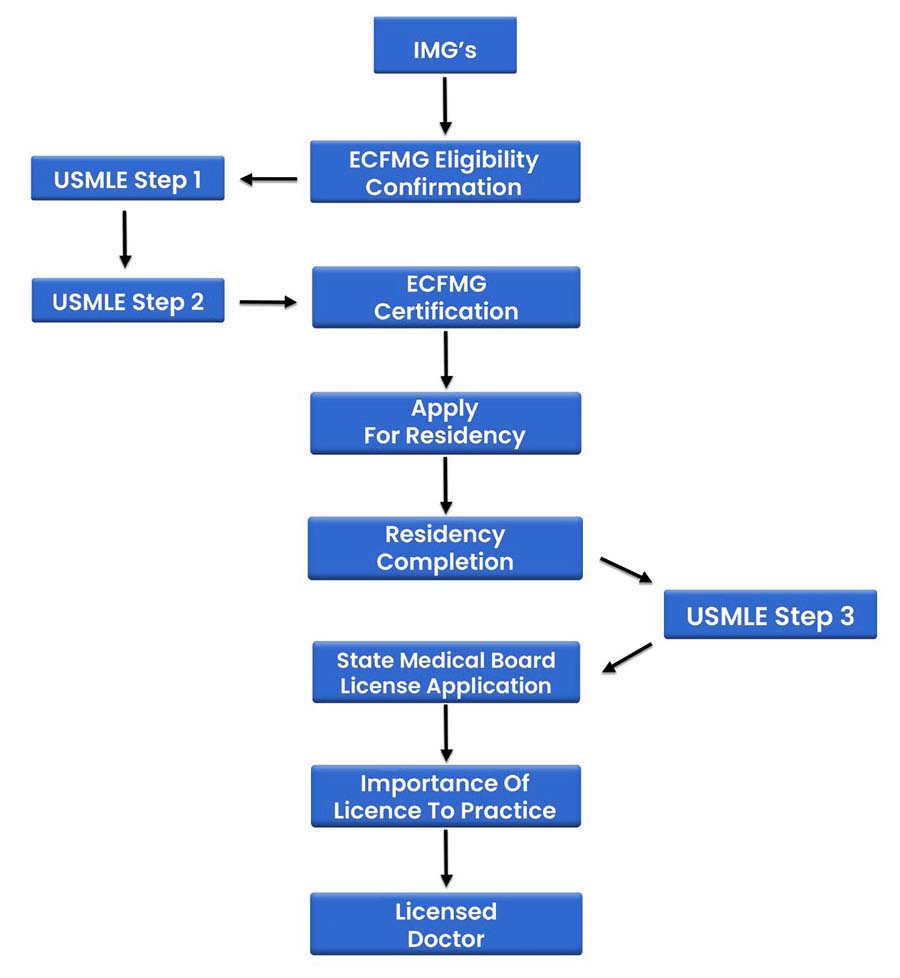The US is a Federation and the States that come together to form the US have significant rights of legislation. Understandably, the US Medical License falls under the purview of the individual States.
To begin with, there are two distinct processes involved when you choose to work as a Doctor in the US – the Medical Licensing and the Board Certification.
The Board Certification (Education Commission for Foreign Medical Graduates ECFMG Certification) is a different procedure altogether.
The ECFMG is centrally managed. It has an elaborate procedure of certification. Through this, the ECFMG tests a Physician meticulously for her knowledge & skills.
But even a Board-certified Doctor in the US practices only after a State grants her an American Medical license.
Obviously, there exist Federal (Central) positions that are filled by medical personnel. For instance, in a Federal facility, say, the US Military or Federal prison, there are many doctors.
But those Doctors also need a license from one US State or the other. However, more commonly, a Doctor practices in the State which grants her a State Medical License. This is, in fact, the actual medical license in USA.
Meanwhile, the contemporary boom in IT has given rise to the concept of “Tele-Medicine”. A physician is able to effectively diagnose and treat cases over long distances. But some states have restrictions in place to prevent that too.
US Medical License: Brief History
To sum up, the right to regulate health was granted to the States in 1791 (Bill of Rights).
However, the historical records reveal that barring a few, all Physicians in the country were practicing without a US Medical License till as late as the 1870s.
Subsequently, towards the end of the decade (1877), with the initiative taken by the State of Illinois, many States started putting laws in place.
Major modifications
Some benchmark modifications to the concept of US Medical License Requirements include –
- early 1900s, the criteria for defining an acceptable ‘Medical School’ began to take shape;
- 1910, most of the States began disqualifying Physicians who studied at medical schools that didn’t meet the criteria;
- By 1935, 50% of the active medical schools that didn’t qualify either merged or closed.
Mild opposition
Like Canada, there was slight opposition to these developments. This is natural because the livelihood of many ‘quacks’ were in jeopardy.
Those who protested argued that the USA Medical License was a conspiracy devised by connected Physicians to eliminate competition and make more money.
Medical Licensing in the US: Procedure
If you wish to know how to become a doctor in USA for foreign doctors, read on!
The International Medical Graduates (IMGs), who wish to practice in the US, need certification at two levels.
Firstly, there's the Board Certification (ECFMG). It makes an IMG eligible to apply for Residency (ACGME accredited residency program).
Secondly, there is the State Medical Board Certification or the US Medical License.
The US Medical License requirements for an IMG are quite elaborate. Certainly, the more developed a nation, the more meticulous is the screening before issuing the practicing license to an IMG.

We present the gist so that you get a picture:
ECFMG checks your eligibility
The ECFMG will allow you to initiate the process of obtaining a US Medical License only if you have completed 4 years of graduation from a Medical School that features in WDOMS (erstwhile IMED).
In addition, your year of graduation must be during the period for which the medical school is mentioned as ‘current’ in WDOMS.
ECFMG certifies you
Undoubtedly, this is the toughest and the most consequential barrier that separates you from your dream of practicing in the US. This is the stage where you need to clear the United States Medical Licensing Examination.
USMLE is essentially the American medical license exam. It also is the medical board exam for foreign graduates.
We consider the United States medical license exam as consequential because it opens doors for Doctors not only in the US but also in other desirable nations like the UK.
Most importantly, the US medical license exam opens doors to PG in the US. After that, you are exempt from appearing in the Indian Medical Licensing exam, the NExT (erstwhile MCI Screening Test/FMGE).
Further, you begin by applying to the ECFMG (the more common expression is ‘applying for the USMLE’) and obtain an ID number.
For that you go through an authentication protocol at the ECFMG website. Then, you complete the ECFMG Certification application process.
For that, you need to furnish a copy of your Medical School Degree or if you are still a student, documentation proving the fact.
You then complete the application procedure using the IWA (Interactive Web Application). Then the ECFMG sets about verifying your credentials, your qualification, medical school, and your transcripts (detailed mark sheets).
Once everything checks out, ECFMG accepts your candidature and you get the schedule of your US medical licensing exam for foreign doctors.
You now appear in the USMLE step 1 & USMLE step 2. Once you clear them as per the requirements of ECFMG, you are issued the ECFMG Certification after complete verification of your USMLE scores.
Apply for Residency
Once you have cleared the USMLE, you need to apply for a Residency (Graduate Medical Education Programs). This process is dependent on two services that you should know about:
- Firstly, you encounter the Electronic Residency Application Services (ERAS) through which you get to submit your Residency application and supporting documents online.
- Then, the National Resident Matching Program (NRMP) comes into play which actually ‘matches’ your choices that you mention in your application to the Residency programs in offer. If you get a ‘match’, your Residency begins!
Complete your Residency
The duration of Residency varies according to the specialty you match for and it could be anywhere between 3 to 7 years.
Clear USMLE step 3
You appear in the USMLE Step 3 exam during your Residency. After clearing Step 3, you are all set to apply for a United States medical license.
Apply for state Medical License
You can find the State Boards' contact details listed on the Federation of State Medical Boards FSMB website .
Make sure that you meet the Medical License requirements by state when you apply as some states may have very specific and different criteria.
Finally, you get your physician License that allows you to practice in the USA.



